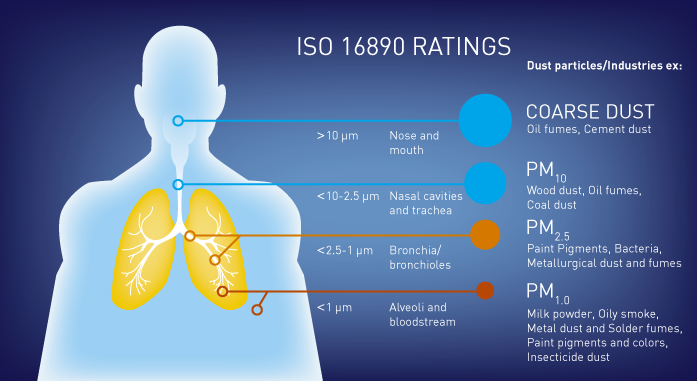ISO 16890 is an international standard that provides a method for evaluating the filtration performance of air filters used in general ventilation systems. It was introduced in 2016 as a replacement for the previously used EN 779 standard, which had limitations in accurately assessing the filtration efficiency of filters for fine particles.
ISO 16890 introduces a new classification system based on a filter’s ability to capture particles of various sizes, including PM1, PM2.5, and PM10. The standard evaluates filters based on their ability to remove particulate matter from the air and assigns them to one of four filter classes:
- ISO Coarse (ISO Coarse 50%, ISO Coarse 65%, ISO Coarse 80%): This class evaluates filters’ performance in capturing larger particles, typically with a diameter of 10 micrometers or more.
- ISO ePM10 (ISO ePM10 50%, ISO ePM10 60%, ISO ePM10 70%, ISO ePM10 80%, ISO ePM10 85%, ISO ePM10 90%): This class evaluates filters’ performance in capturing particles with a diameter of 10 micrometers or less, including PM10 particles.
- ISO ePM2.5 (ISO ePM2.5 50%, ISO ePM2.5 60%, ISO ePM2.5 70%, ISO ePM2.5 80%, ISO ePM2.5 85%, ISO ePM2.5 90%): This class evaluates filters’ performance in capturing particles with a diameter of 2.5 micrometers or less, including PM2.5 particles.
- ISO ePM1 (ISO ePM1 50%, ISO ePM1 60%, ISO ePM1 70%, ISO ePM1 80%, ISO ePM1 85%, ISO ePM1 90%): This class evaluates filters’ performance in capturing particles with a diameter of 1 micrometer or less.
The percentage value associated with each filter class represents the minimum average filtration efficiency required for that particular particle size range. For example, ISO ePM2.5 80% means the filter must have a minimum average filtration efficiency of 80% for PM2.5 particles.
ISO 16890 provides a more comprehensive and accurate assessment of a filter’s performance by considering multiple particle size ranges. This allows for better selection and comparison of filters based on their actual ability to remove fine particles, including PM2.5, from the air.

